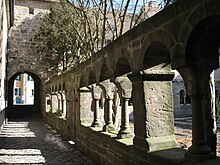 | ||
| Wet cheeks | ||
| federal state | Bavaria | |
|---|---|---|
| Residents | 12.452 (2019) | |
| height | 497 m | |
| no tourist info on Wikidata: | ||
| location | ||
| ||
The town Wet cheeks is located on the Romantic road in the district Ansbach in Middle Franconia southwest of Ansbach not far from the state border too Baden-Wuerttemberg.

background
The city is on the Swiss franc amount, a part of the Swabian-Franconian layered plain, in the valley of the Sulzach. It originated from the Benedictine monastery of St. Salvator, which was first mentioned around 818 and which was later transferred to the diocese augsburg came. The monastery, which was later converted into a canons, was the site of important pilgrimages until the Reformation. The settlement next to the monastery is named as an imperial city in 1241. It later came to the Margraviate of Ansbach by pledging.
After a short Prussian interlude, Feuchtwangen became part of the newly established kingdom in 1806 Bavaria. A Jewish community had existed in the city since the 13th century, and until 1938 the Jewish residents left the city under the pressure of persecution. The synagogue was burned down in November 1938, and the Franconian Museum is now being built in its place. In the 1970s, numerous surrounding communities were incorporated.
getting there
By plane
The nearest airports are Nuremberg Airport![]() (IATA: NUE), 100 km away, and the Stuttgart Airport
(IATA: NUE), 100 km away, and the Stuttgart Airport![]() (IATA: STR), 150 km.
(IATA: STR), 150 km.
By train
Feuchtwangen is on the railway line Nordlingen-Dombühl, on which there is no longer any regular passenger traffic. Only museum trains run from Nördlingen.
The next regularly served train station is around 11 km north in 1 Dombühl, on the Stuttgart – Nuremberg railway line (via Crailsheim and Ansbach). It is served by regional express trains every two hours and is the end point of Nuremberg S-Bahn line 4 (also every two hours).
From the Dombühl train station, you can take the 813 bus (once an hour) to Feuchtwangen in 20 minutes. Central bus stop is 2 Feuchtwangen Mooswiese, immediately southwest of the old town center (250 meters from the market square).
The next train station to which long-distance trains can travel is in Ansbach; it gets every two hours from the intercity line Karlsruhe–Nuremberg served. Also from direction Wurzburg and augsburg/Munich there are connections in Ansbach. The 805 bus goes from Ansbach train station to Feuchtwangen, the journey takes 45 minutes.
In the street
Feuchtwangen is not far from the Feuchtwangen / Crailsheim motorway junction, where the A 6 (Nuremberg–Heilbronn) and A 7 (Wurzburg–Ulm) to encounter. The A 6 can be reached at the junction ![]() 49 Leave (Feuchtwangen-Nord), then it is 8 km on the federal road 25 to the city center; from the A 7, exit
49 Leave (Feuchtwangen-Nord), then it is 8 km on the federal road 25 to the city center; from the A 7, exit ![]() 111 (Feuchtwangen-West) there are around 6 km of country road to the center of Feuchtwangen.
111 (Feuchtwangen-West) there are around 6 km of country road to the center of Feuchtwangen.
Those who prefer to travel a little slower and want to make stops along the way can reach Feuchtwangen on the Romantic roadwhose course corresponds to the B 25: from the south of Dinkelsbühl, Nördlingen, Donauwörth and augsburg or from north of Rothenburg ob der Tauber, Bad Mergentheim and Wurzburg.
By boat
No navigable waters lead to Feuchtwangen.
By bicycle
The long-distance cycle path (Germany route) D9, which corresponds to the course of the Romantic Road, leads through Feuchtwangen. The next stages are Schillingsfürst and Rothenburg ob der Tauber in the north as well as Dinkelsbühl and Nördlingen.
mobility
The is responsible for the bus routes in the region VGN (Transport association for the greater Nuremberg area).
- Line 813: Dombühl - Feuchtwangen.
Tourist Attractions


- The Protestant parish church (former Collegiate church) goes back to Romanesque and Gothic foundations, but has been restored and rebuilt several times. Late Gothic winged altar from 1484, reassembled and supplemented in 1901. The late Romanesque cloister, of which two wings have been preserved, is now the backdrop for the open-air theater of the cloister plays.
- The evangelical Side church of St. Johannis from around 1400.
- The ones that were essentially preserved by building fixtures City fortifications; of the original three gates, only the converted upper gate is still standing.
- It is famous Street scene the city that was not destroyed in the war, especially on the market square, with its mostly eaves-side old town houses, including the deanery, the former municipal hospital and the former Katen, an elongated half-timbered building.
activities

Museums
- The Franconian Museum
- The Singers Museum
- The Craftsmen's rooms in the cloister
Events
- Cloister games, since 1948
- Old town festival at the market square
- Summer feeling festival
- Christmas Market
shop
kitchen
nightlife
accommodation
health
Practical advice
| Brief information | |
| surface | 137.2 km² |
|---|---|
| Phone code | 09852 |
| Post Code | 91555 |
| Mark | AT |
| Time zone | UTC 1 |
| Emergency call | 112 / 110 |
trips
- Ansbach, 23 km to the northeast, former residential town with castle, courtyard garden and an old town that is well worth seeing
- Dinkelsbühl, 11 km south, romantic medieval old town
- Ellwangen, 34 km southwest
- Nordlingen, 44 km south
- The Hesselberg in the Swiss franc amount at Wassertrüdingen, the highest mountain in Middle Franconia with a wide view, almost 20 km southeast
literature
Web links
http://www.feuchtwangen.de - Official website of Feuchtwangen



